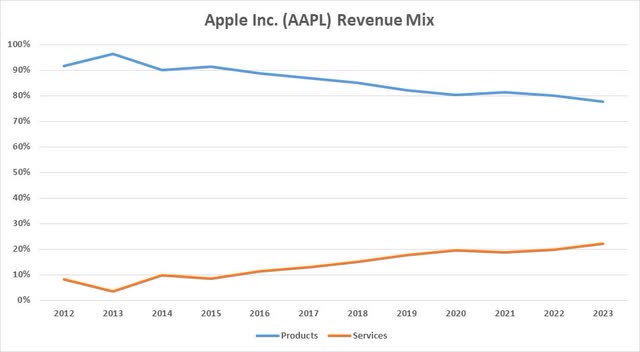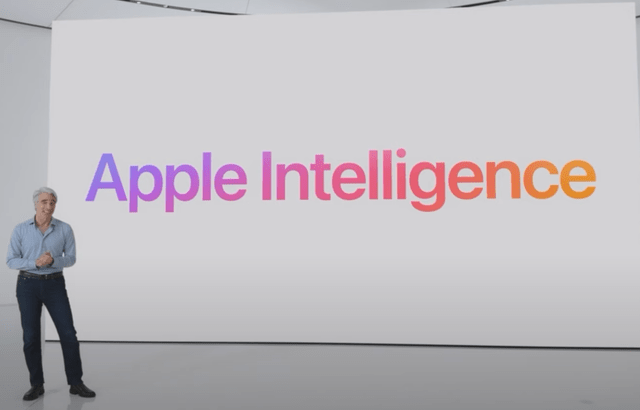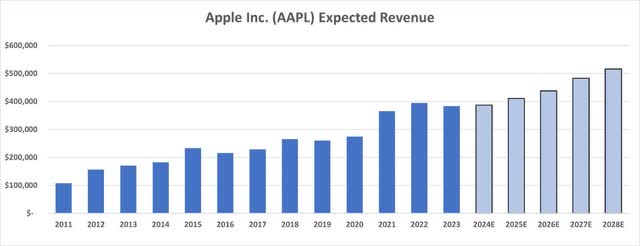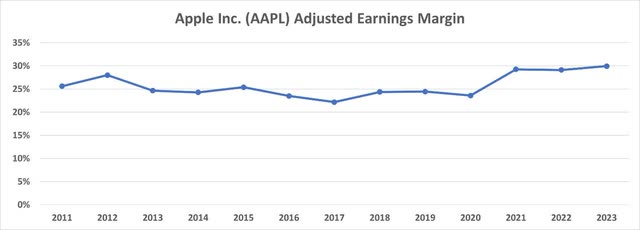Summary:
- WWDC 2024 was amazing, as Apple finally made its long-overdue leap into AI by introducing Apple Intelligence.
- While the new features are great for existing users, I am skeptical that they will attract non-Apple users or generate higher-than-expected earnings.
- Combined with my DCF analysis, which indicates that Apple’s stock is accurately priced, I am assigning a “Hold” rating to the stock.
Nikada/iStock Unreleased via Getty Images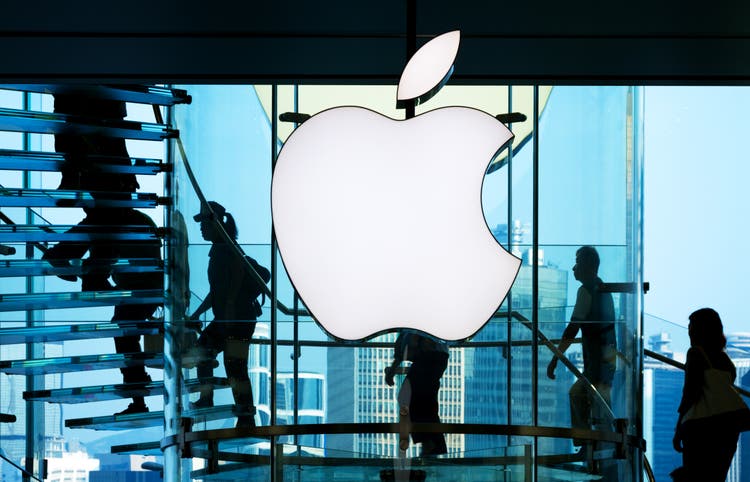
Introduction
There is much to say about Apple (NASDAQ:AAPL) (NEOE:AAPL:CA). Once the largest company in the world, it was initially successfully challenged by Microsoft (MSFT) and is now facing competition from Nvidia (NVDA) for its second position.
While big technology firms jumped on artificial intelligence to explore its potential applications, Apple has remained mostly silent. That is, until now
On the 10th of June 2024, the date this article was written, Apple had its annual Worldwide Developers Conference. During the event, the company finally delivered what users had long been expecting. Apple Intelligence was introduced, and there have been big improvements in user experience.
However, like other companies trying to leverage AI to enhance software, Apple faces a monetization issue. It is great that it enhances user experience, but for higher valuations, this improved experience should translate into higher earnings. I am skeptical about the added financial benefits that AI will bring.
In addition, my valuation model indicates that the stock is accurately priced, leading to my “Hold” rating for the company.
Like I always do, I will start with a brief review of the business and discuss what has been going on in the past decade. We’ll talk about the WWDC Event right after.
Business Description
Apple doesn’t need a detailed business description. However, I like to start my articles by explaining how the company generates earnings. In Apple’s case, it is very straightforward.
In fiscal year 2023, more than half of Apple’s total revenue came from iPhone sales. Around 26% of its earnings came from other products such as Mac, iPad, wearables, and home and accessories. The remaining 22% was services, including the Apple Store, Apple TV, and Apple Pay.
Interestingly, over time, Apple has been becoming more of a service company than a product-based company. While services accounted for less than 10% of revenue in 2012, they generated 22% of revenue in 2023.
The gross margin of services provided is significantly higher than that of products. Thanks to this shift in revenue mix and pricing increases, the company managed to keep its earnings margin high.
However, as Apple grew, it started producing more products than it could sell. That’s why both inventory turnover and adjusted return on assets show a sharp decline over the last decade.
S&P Capital IQ S&P Capital IQ & Author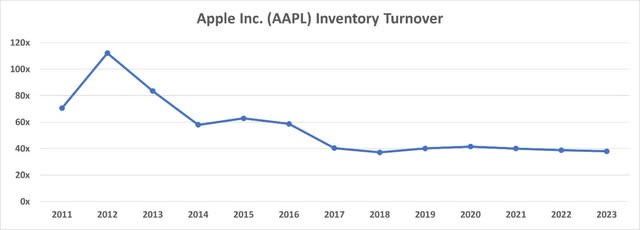
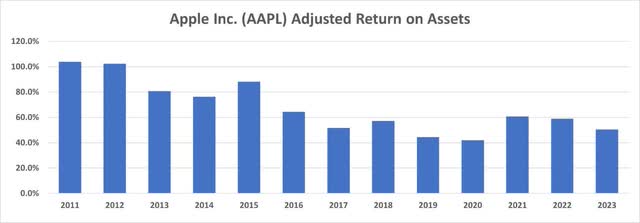
This is partly caused by increasing competition in smartphones and computers. When the first iPhone was introduced back in 2007, it completely changed the way we perceived phones. However, over the years, Apple has not been pioneering technology to the same significant degree.
The company seems to be aware of this, as evidenced by announcements at this year’s Worldwide Developers Conference. Now, it is Apple’s time to put pressure on its competitors.
Without further ado, let’s analyze the news everyone has been waiting for and its implications for the future of Apple.
WWDC Event Highlights
Good news first. Apple has finally found something to do with its huge cash position and delivered everything its users wanted at this year’s Worldwide Developers Conference. That was among other things, artificial intelligence.
First of all, Apple did really show why it’s the best in user experience. The first half of the presentation was dedicated to IOS 18 and how it makes the lives of Apple customers easier. The iPad got a calculator app, there were design improvements, Apple Pay online and “Tap to Cash” were introduced, and there were improvements made to the connectivity of devices, such as using the iPhone on a Mac.
The big news came in the second part. That was not the AI everyone expected, but it was “Apple Intelligence”. The company seems to be taking big steps to be able to compete with other big technology companies. Let’s break down the three main developments from this announcement:
- Apple will provide personalized artificial intelligence solutions on the phone. Users’ data will not leave the device unless necessary and approved by the user. Thanks to its powerful M4 chip, the device will be able to process the data locally. This is incredibly important and presents a solution to one of the worries with Open AI’s ChatGPT. Apple users will not have to worry about their data being stored in a random data center on the other side of the world.
- Siri gets a big update and becomes the voice assistant everyone has wanted for years. Users can talk to or type to Siri about pretty much anything, and it will deliver. An example given was a user asking if they can make it to a lunch reservation after picking up their mom. Siri will be able to gather information from different applications, identify the reservation details, when mom needs to be picked up, and how long it will take to drive to the restaurant.
- Finally, Apple revealed a partnership with OpenAI. ChatGPT is integrated into the Apple ecosystem. Once Siri determines that ChatGPT might provide a better answer, it asks the user for permission to send the data to OpenAI. If approved, it will directly connect to ChatGPT. This announcement has been expected for a long time.
Overall, the event gave users everything they wanted from user experience improvements to artificial intelligence, or more accurately, Apple Intelligence.
Monetization Remains a Question
Now, these is all amazing news for users. However, they are not necessarily as positive for investors. At the very least, they require a deeper dive-in.
We have seen huge investments in the infrastructure needed to build artificial intelligence models. That has been one of the biggest drivers of demand for Nvidia. However, when it comes to actually implementing artificial intelligence to provide better solutions and monetizing them, companies seem to struggle.
For an AI implementation to benefit existing shareholders, the company must clearly outline the added benefits.
Take Adobe (ADBE) as an example. The stock surged significantly in 2023. The company introduced impressive solutions as part of its Photoshop and Firefly software products. However, the stock has fallen nearly 27% since January because the company failed to present a solid monetization strategy for its offerings. Management argues that these new AI offerings allow the company to reach more subscribers, and I think they are right. But after the first jump in the number of subscribers, the growth story is a bit uncertain. That is why the market has been reconsidering the stock.
I fear Apple might have a similar problem. Apple Intelligence is going to be integrated in IOS 18 for free. Users do not have to pay anything in addition when they buy an Apple product compatible with Apple Intelligence and create an account. So, Apple will not earn more money by selling the feature. We saw how enhancing current offerings with AI did not necessarily lead to sustained higher growth expectations and higher equity value with the Adobe example.
As discussed in the business description, Apple generates most of its earnings through device sales, in particular the iPhone. If the company does not charge for Apple Intelligence, they will need to show that this new offering leads to higher-than-expected device sales. While this is a great feature for user experience and existing loyal Apple customers will certainly enjoy it, I am skeptical this will significantly expand this loyal customer base. If the customer base doesn’t expand, it is tough for shareholders to see improvements in earnings per share related to Apple Intelligence.
To conclude this section, I believe Apple will continue to grow its earnings mostly through price increases and sales of new versions of its devices, as it has been doing. There does not seem to be any monetization strategy tied to Apple Intelligence, and there will be limited additional financial benefits from it. Moreover, although there could be new customers impressed by these features and considering buying an Apple product for the first time, I believe similar features will be adopted by Apple’s cheaper alternatives by the end of this year, increasing competition.
In summary: It is awesome for users, but not necessarily for investors.
Valuation
I will be using a Discounted Cash Flow model for valuation. I am basing my future earnings expectations based on revenue growth and earnings margin.
I do believe Apple can keep growing at a sustainable rate thanks to its loyal user base and pricing updates to battle inflation and increase margins. Below is a chart showing Apple’s revenue since 2011, with my estimates for the next 5 years. Based on the current macroeconomic outlook and analysts’ expectations, my 2024 estimate is only slightly higher than 2023.
The second variable is earnings margin. Apple was able to sustain an adjusted earnings margin of around 25% for the last decade. 2021 was a great year both for the top and bottom lines. The adjusted earnings margin seems to be flat at 30%. I am positive that Apple will be able to sustain this level of adjusted earnings margin, at least for the next 5 years.
Adjusting earnings for CAPEX and other non-cash expenses and profits, I calculate the cash earnings.
I am using 3% as the terminal growth rate. This is slightly higher than the long-term inflation target of 2%, as I believe Apple can sustain its growth for longer. Using a long-term risk-free rate of 2%, a market risk premium of 5.7%, the stock’s 5-year equity beta of 1.25, and 4.5% as the cost of debt gives me a discount rate of around 7%.
I also may be using a different cash number in my equity value calculation. I calculate the excess cash, as I believe that’s what the investors have a claim on, not the operating cash that is going to be used next year for expenses like salaries.
Using these numbers, I find an equity value of $2.89 trillion, which means a target share price of $186.96 when I include the diluted common shares. This is a 3.2% downside over the current share price at the time of this article’s writing.
Author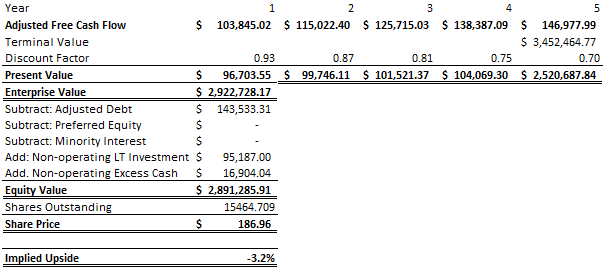
Conclusion
I am not an Apple user. I prefer my Excel sheets on Windows. However, I have to say that I am impressed by what I heard today at the conference. All the user experience improvements aside, what is now possible with Siri seems limitless.
Although I really liked these new developments, I am skeptical that this better user experience will translate to higher-than-expected sales and earnings. Like many other companies implementing AI, Apple seems to lack a good monetization strategy.
Combined with my DCF analysis that shows the stock is accurately priced, I am assigning a “Hold” rating to the stock. I am curious about how they will use Apple Intelligence to drive earnings higher, and will be tracking how this thesis develops.
Analyst’s Disclosure: I/we have no stock, option or similar derivative position in any of the companies mentioned, and no plans to initiate any such positions within the next 72 hours. I wrote this article myself, and it expresses my own opinions. I am not receiving compensation for it (other than from Seeking Alpha). I have no business relationship with any company whose stock is mentioned in this article.
Seeking Alpha’s Disclosure: Past performance is no guarantee of future results. No recommendation or advice is being given as to whether any investment is suitable for a particular investor. Any views or opinions expressed above may not reflect those of Seeking Alpha as a whole. Seeking Alpha is not a licensed securities dealer, broker or US investment adviser or investment bank. Our analysts are third party authors that include both professional investors and individual investors who may not be licensed or certified by any institute or regulatory body.

